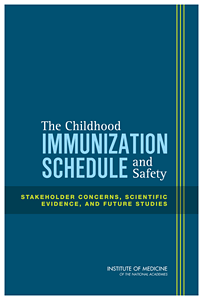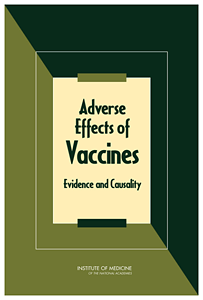Partner Reports on Vaccine Safety
CDC’s vaccine safety systems help ensure vaccines are as safe as possible. These monitoring systems help scientists conduct high-quality vaccine safety research. This research is then peer-reviewed and published in reputable scientific outlets.
CDC also closely partners with other federal, state, and local agencies, as well as private entities, to monitor and communicate about the safety of vaccines.
Agency for Healthcare Research and Quality (AHRQ)
AHRQ is the lead federal agency charged with improving the safety and quality of America’s healthcare system. AHRQ’s mission is to produce evidence to make health care safer, higher quality, more accessible, equitable, and affordable, and to make sure that the evidence is understood and used.
In 2014, AHRQ developed a report based on a systematic review of vaccine safety that builds upon the 2011 Institute of Medicine (IOM) report: Adverse Effects of Vaccines: Evidence and Causality. Since the first report came out, the vaccination schedule evolved to include newly approved vaccines and changes to several existing vaccines.
Safety of Vaccines Used for Routine Immunization in the United States: An Update – 2021
Agency for Healthcare Research and Quality. Safety of Vaccines Used for Routine Immunization in the United States: An Update. AHRQ Publication No. 21-EHC024 May 2021.
In May 2021, AHRQ released an updated report of the Safety of Vaccines Used for Routine Immunization in the United States. Researchers conducted a systematic review of the published scientific research (literature) on the following vaccines, which are recommended for routine immunization in adults, pregnant people and children and adolescents:

- Diphtheria, Tetanus and Acellular Pertussis (DTaP)
- Haemophilus influenzae type b (Hib)
- Hepatitis A
- Hepatitis B
- Human Papillomavirus (Gardasil)
- Influenza (inactivated, recombinant and live)
- Inactivated Polio
- Measles, Mumps, and Rubella (MMR)
- Meningococcal ACWY
- Meningococcal B
- Pneumococcal (13- and 23-valent)
- Rotavirus
- Tetanus, diphtheria (Td)
- Tetanus, diphtheria and acellular pertussis (Tdap)
- Shingles (Shingrix)
- Varicella (chickenpox)
For this update, researchers reviewed nearly 57,000 citations and found 189 studies that addressed key questions evaluating the vaccines above and in the specific populations, adding to data in the prior 2014 report, for a total of 338 included studies reported in 518 publications.
Safety signals from the prior report remain unchanged for adverse events, including:
- Anaphylaxis in adults and children
- Febrile seizures in children
- Idiopathic Thrombocytopenia Purpura in children
This report did not find any new evidence of increased risk for key adverse events following administration of vaccines that are routinely recommended for adults, children, and pregnant people. There remains insufficient evidence to make conclusions about some rare potential adverse events.
The National Academy of Medicine (NAM) – formerly Institute of Medicine (IOM)
Founded in 1970 as IOM, NAM is one of three academies that make up the National Academies of Sciences, Engineering, and Medicine (the National Academies) in the United States. As part of a restructuring of the National Academies in 2015, IOM became NAM. The National Academies are private, nonprofit institutions that work outside of government to provide objective advice on matters of science, technology, and health.
Occasionally, the U.S. Department of Health and Human Services (HHS) asks NAM to examine all of the current medical and scientific evidence on a particular topic. Below are summaries of historical IOM reports relating to vaccine safety.
The Childhood Immunization Schedule and Safety – 2013
Institute of Medicine. 2013. The Childhood Immunization Schedule and Safety: Stakeholder Concerns, Scientific Evidence, and Future Studies. Washington, DC: The National Academies Press. https://doi.org/10.17226/13563.
The IOM convened the Committee on Assessment of Studies of Health Outcomes Related to the Recommended Childhood Immunization Schedule to conduct an independent evaluation of the safety of the childhood immunization schedule.
The IOM issued their report on January 16, 2013. In it, the Committee expressed support for the recommended childhood immunization schedule as a tool to protect against vaccine-preventable diseases. The Committee recommended using healthcare records data to continue studying the safety of vaccines. The Committee also reconfirmed a finding of the National Vaccine Advisory Committee (NVAC) white paper that said conducting a study requiring some children to receive fewer vaccines than recommended, as would be needed for a randomized controlled trial, would be unethical. However, the committee concluded that the Vaccine Safety Datalink (VSD) is the best available system for studying the safety of the immunization schedule in the United States.

Child and Adult Immunization Schedules
Get CDC’s official recommended immunization schedules for children, adolescents, and adults.
Adverse Effects of Vaccines: Evidence and Causality – 2012
Institute of Medicine. 2012. Adverse Effects of Vaccines: Evidence and Causality. Washington, DC: The National Academies Press. https://doi.org/10.17226/13164.
HHS charged the IOM with providing a thorough review of the current medical and scientific evidence on vaccines and vaccine adverse events.
The IOM Committee on Vaccines and Adverse Events released its report on August 25, 2011. This analysis was used to update the Vaccine Injury Table [PDF – 12 Pages]for the National Vaccine Injury Compensation Program (VICP). The report provides a scientific basis for future review and decisions on VICP claims. The IOM Committee used peer-reviewed literature to review eight vaccines given to children or adults:

- Measles, Mumps, and Rubella (MMR)
- Varicella
- Influenza
- Hepatitis A
- Hepatitis B
- Human papillomavirus (HPV)
- Meningococcal
- Diphtheria-toxoid-, tetanus toxoid-, and acellular pertussis-containing vaccines
The findings indicate that these vaccines are safe and that serious adverse events are quite rare. The IOM has conducted two similar extensive reviews in the past. The last one was published in 1994.